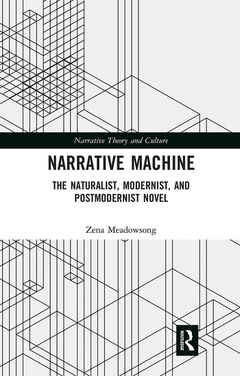Narrative Machine The Naturalist, Modernist, and Postmodernist Novel Narrative Theory and Culture Series
Auteur : Meadowsong Zena

Narrative Machine: The Naturalist, Modernist, and Postmodernist Novel advances a new history of the novel, identifying a crucial link between narrative innovation and the historical process of mechanization. In the late nineteenth century, the novel grapples with a new and increasingly acute problem: In its attempt to represent the colossal power of modern machinery?the steam-driven machines of the Industrial Revolution, the electrical machines of the modern city, and the atomic and digital machines developed after the Second World War?it encounters the limitations of traditional representative strategies. Beginning in the naturalist novel, the machine is typically portrayed as a mythic monster, and though that monster represents a potentially horrific reality?the superhuman power of mechanization?it also disrupts the documentary objectives of narrative realism (the dominant mode of nineteenth-century fiction). The mechanical monster, realistic and yet at odds with traditional realist strategies, tears the form of the novel apart. In doing so, it unleashes a series of innovations that disclose, critique, and contest the force of mechanization: the innovations associated with literary naturalism, modernism, and postmodernism.
Introduction Part 1. Naturalism and the Mechanical Monster Chapter 1: Zola’s monster machines Chapter 2: Mechanical monsters in England and America Chapter 3: The machined aesthetics of Dreiser, Crane, Moore, Wharton, and Gissing Part 2. Modernism versus the Machine Chapter 4: Lawrence and the monster machine Chapter 5: Joyce’s utopian machine Chapter 6: Against the quotidian machine: Woolf, Hemingway, and Proust Part 3. Postmodernism: Living with the Machine Chapter 7: The new sunshine: Ballard, Vonnegut, and Dick Chapter 8: The digital and atomic plots of Pynchon and DeLillo Chapter 9: The machinery of liberation: Georges Perec
Zena Meadowsong is an Associate Professor of English at Rowan University, USA.
Date de parution : 09-2020
15.2x22.9 cm
Date de parution : 12-2018
15.2x22.9 cm
Thème de Narrative Machine :
Mots-clés :
Young Man; ICBM; history of the novel; Intercontinental Ballistic Missile; Industrial Revolution; Tragic Flaw; modern city; Draws Back; WWII; Mechanical Monster; World War II; Napoleon III; Second World War; Fractured Stream; 19th Century Fiction; Functional Order; Nineteenth Century Literature; Ascent Ramp; narrative; Le Voreux; narrative realism; Mummer’s Wife; Frank Norris; Georges Perec; Thomas Hardy; Plastic Molecule; Theodor Dreiser; Kilgore Trout; Stephen Crane; Gravity’s Rainbow; George Moore; Grub Street; Edith Wharton; Underworld Men; George Gissing; Carrie Meeber; D.H; Lawrence; Rougon Macquart Novels; James Joyce; Iron Determinism; Virginia Woolf; Jasper Milvain; Ernest Hemingway; Functional Language; Marcel Proust; Sprint; J.G; Ballard; Factory Scene; Kurt Vonegut; Philip K; Dick; Thomas Pynchon; Don DeLillo; mechanics; technology; machines; innovation; monstrosity; transformation; naturalism; industrialization; humanity; utopia; narrative theory; novel; comparative literature



